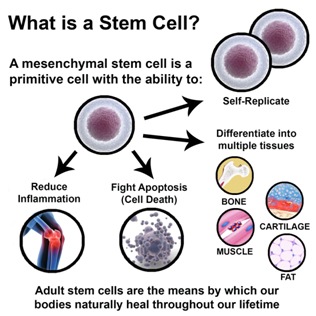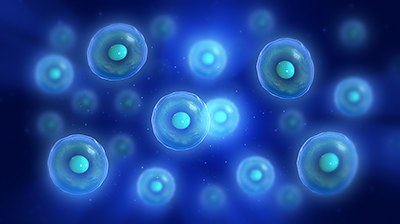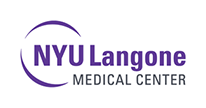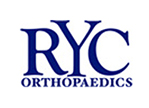Stem Cell Therapy/PRP
Scientists and doctors have made tremendous advances in moving regenerative medicine into the mainstream as a treatment for many diseases and disorders. Regenerative medicine takes advantage of our natural ability to heal ourselves by using the healthy adult stem cells found throughout the body. Laboratory and clinical research has shown that it is possible to use adult stem cells to restore lost, damaged or aging cells to effectively regenerate tissue and provide some patients with an alternative to surgery. Regenerative therapies are showing promise in orthopedic medicine, wound care, nerve restoration, and a variety of cardiovascular, neuromuscular, and autoimmune conditions.

What are Adult Stem Cells?
Adult stem cells were discovered over 40 years ago when researchers found that cells derived from bone marrow had the ability to form various tissues. Adult stem cells are early stage cells that, under the right conditions, are capable of developing into other types of cells and hold the potential to regenerate damaged tissue.

AUTOLOGOUS ADULT STEM CELLS (ASCS) are being used to treat many types of chronic pain and degeneration. Currently doctors are treating shoulder, knee, hip, and spine degeneration, in addition to soft tissue (muscle, tendon, ligament) and other bone related injuries.
Who is a Good Candidate for a Stem Cell Procedure?
The first step is to determine if you are a good candidate for an adult stem cell procedure. Your physician will want a history of your injury and a physical examination along with any x-rays, and an MRI. While stem cell therapy maybe appropriate for certain conditions, it is not applicable for every condition. However, it is has proven to be a viable option for several individuals suffering from pain. Good candidates for adult stem cell treatment usually are:
- A patient that wants to avoid the inherent complications that come with an invasive surgical procedure
- A pain sufferer that is interested in an option that offers potential for an overall improved quality of life
- A person who understands that surgery sets off a cascade of further degeneration, and is prepared to benefit from the body’s own regenerative mechanisms.
Every patient is different, the success of the stem cell therapy is dependent on the severity of your condition and your body’s response to stem cell therapy.
Overview of the Procedure
An adult stem cell procedure harnesses’ and amplifies the body’s natural mechanism for healing and anti-inflammation. Once you have been identified as a good candidate for the procedure, a member of our team will review the procedure with you and answer any questions that you may have. A brief overview of the procedure is below:
- This mechanism uses adult autologous stem cells, derived from your own bone marrow.
- In the procedure, the physician will aspirate these cells from your hip, concentrate them, then deliver them back into your body in the area of damage or injury to aid in natural healing.
- In all, the process takes less than 45 minutes and the concentration of the cells takes about 12-14 minutes.
- Because your procedure will utilize a concentrated serum of your own cells, the procedure is considered “autologous point-of-care”.
Once the procedure is complete, our staff will allow you to rest and will create a customized personal rehabilitation program for recovery. We will either ask you to come back for a few post-operative appointments or follow up with you by phone, email, or mail so we can track you healing progress.
Potential Applications
- The spine is comprised of a team environment working together to provide function and mobility to the body. If an area of the neck or back is injured, the entire structure begins to compensate for the injury causing stability and function to decline. Creating the need to relieve this pain:
- Possible conditions for treatment are: discogenic back pain, facet arthritis and degenerative disc disease.
- Your shoulder is involved in small and large movements throughout the day. Shoulder injuries can be the result of the tiniest movements from writing to driving a car. Most people do not even know they are suffering from a shoulder injury. Once the injury is identified the pain can become intolerable. Creating the need to relieve this pain:
- Possible conditions for shoulder treatments are partial rotator cuff tears, labral tears, and mild to moderate osteoarthritis
- The knee joint is used in almost all motion and over time will begin to degenerate from overuse. Knee pain can be extremely pain full and challenging for anyone suffering from joint pain. Creating the need to relieve this pain:
- Possible conditions for knee treatment are osteoarthritis, partial ligament tears: ACL & PCL, partial meniscal tears, and augmented ACL or PCL reconstruction
- Foot and ankle injuries often occur. Over time, we collect scars making it difficult for our body to heal on its own. The constant pressures we cause with simples, line walking or stretching, often exasperate the injury. Creating the need to relieve this pain:
- Possible conditions for treatment: are mild to moderate osteoarthritis, tendon inflammation, partial achilles tendon tear, and muscle strain/sprain.
- The constant motion of walking, running, biking or climbing involves our hips. The compression of these movements starts to wear on all our joints over time. In addition, the hip’s have a tendency to carry much of the burden on our body’s motions and pain. Creating the need to relieve this pain:
- Possible conditions for treatments are: osteoarthritis, laberal tears, articular cartilage injuries and conginetal deformities of the hip
Platelet Rich Plasma (PRP)
What is Platelet-Rich Plasma (PRP)?
Our blood consists of a liquid component known as plasma. It also consists of three main solid components which include the red blood cells (RBCs), white blood cells (WBCs), and platelets. Platelets play an important role in forming blood clots. They also consist of special proteins, known as growth factors, which help with our body’s healing process. Platelet-rich plasma or PRP is a high concentration of platelets and plasma. A normal blood specimen contains only 6% platelets, while platelet-rich plasma contains 94% of platelets and 5 to 10 times the concentration of growth factors found in normal blood, thus greater healing properties.
What are the Indications for PRP Injections?
PRP is a relatively new method of treatment for several orthopedic conditions such as muscle, ligament, and tendon injuries; arthritis; and fractures. PRP injections can help alleviate painful symptoms, promote healing, and delay joint replacement surgeries.
Platelet-Rich Plasma Injection Procedure
Your doctor will first draw about 20 cc's of blood from the large vein in your elbow. The blood is then spun in a centrifuge machine for about 5 minutes to separate the platelets from the remaining blood components. The injured part of your body is then anesthetized with a local anesthetic. The platelet-rich portion of your blood is then injected into your affected area. In some cases, your doctor may use ultrasound guidance for proper needle placement.
Post-Procedure Care following PRP Injections
It is normal to feel some discomfort at the injection site for a few days after your procedure.
- You may use cold compresses to alleviate your symptoms.
- You will be instructed to stop any anti-inflammatory medications.
- You may resume your normal activities but should avoid any strenuous activities such as heavy lifting or exercises.
Risks and Complications of PRP Injections
There are very minimal risks associated with PRP injections. Some of the potential risks include:
- Increased pain at the injection site
- Infection
- Damage to adjacent nerves or tissues
- Formation of scar tissue
- Calcification at the injection site





